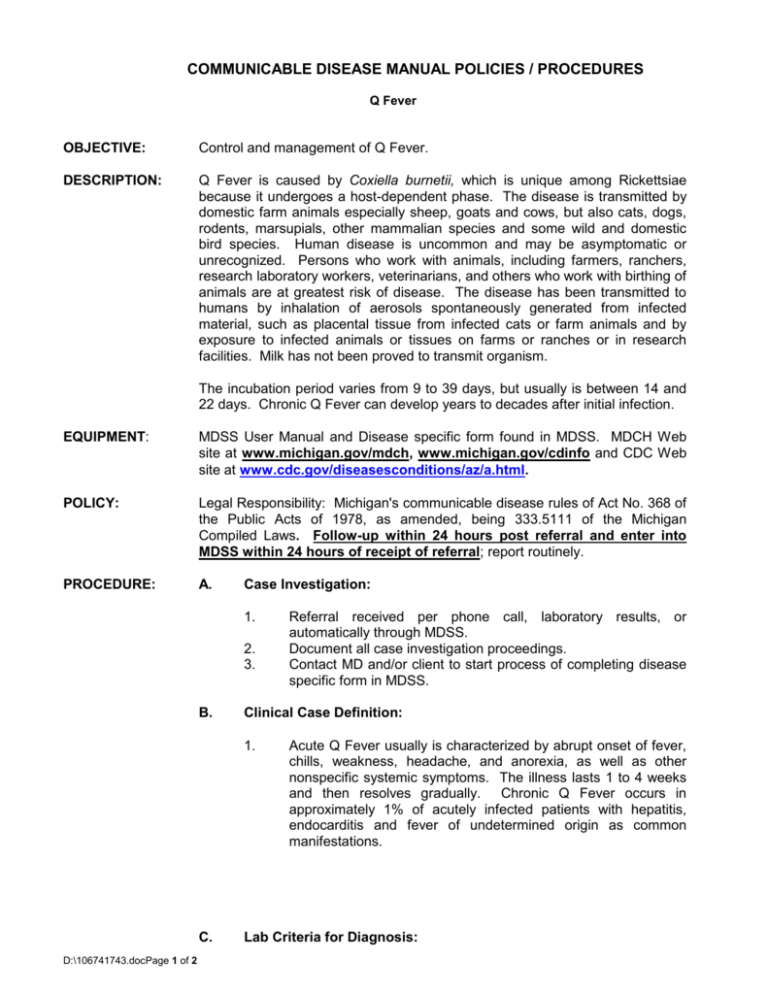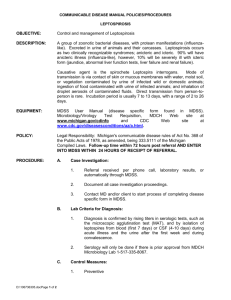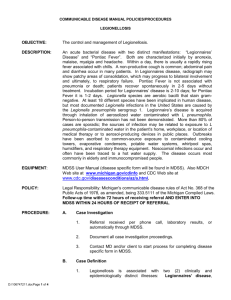Q Fever
advertisement

COMMUNICABLE DISEASE MANUAL POLICIES / PROCEDURES Q Fever OBJECTIVE: Control and management of Q Fever. DESCRIPTION: Q Fever is caused by Coxiella burnetii, which is unique among Rickettsiae because it undergoes a host-dependent phase. The disease is transmitted by domestic farm animals especially sheep, goats and cows, but also cats, dogs, rodents, marsupials, other mammalian species and some wild and domestic bird species. Human disease is uncommon and may be asymptomatic or unrecognized. Persons who work with animals, including farmers, ranchers, research laboratory workers, veterinarians, and others who work with birthing of animals are at greatest risk of disease. The disease has been transmitted to humans by inhalation of aerosols spontaneously generated from infected material, such as placental tissue from infected cats or farm animals and by exposure to infected animals or tissues on farms or ranches or in research facilities. Milk has not been proved to transmit organism. The incubation period varies from 9 to 39 days, but usually is between 14 and 22 days. Chronic Q Fever can develop years to decades after initial infection. EQUIPMENT: MDSS User Manual and Disease specific form found in MDSS. MDCH Web site at www.michigan.gov/mdch, www.michigan.gov/cdinfo and CDC Web site at www.cdc.gov/diseasesconditions/az/a.html. POLICY: Legal Responsibility: Michigan's communicable disease rules of Act No. 368 of the Public Acts of 1978, as amended, being 333.5111 of the Michigan Compiled Laws. Follow-up within 24 hours post referral and enter into MDSS within 24 hours of receipt of referral; report routinely. PROCEDURE: A. Case Investigation: 1. 2. 3. B. Clinical Case Definition: 1. C. D:\106741743.docPage 1 of 2 Referral received per phone call, laboratory results, or automatically through MDSS. Document all case investigation proceedings. Contact MD and/or client to start process of completing disease specific form in MDSS. Acute Q Fever usually is characterized by abrupt onset of fever, chills, weakness, headache, and anorexia, as well as other nonspecific systemic symptoms. The illness lasts 1 to 4 weeks and then resolves gradually. Chronic Q Fever occurs in approximately 1% of acutely infected patients with hepatitis, endocarditis and fever of undetermined origin as common manifestations. Lab Criteria for Diagnosis: 1. D. E. Control Measures: 1. Tetracycline or doxycycline is the drug of choice and chloramphenicol is an alternative. Tetracyclines should not be given to children younger than 8 years of age unless the benefit is greater than the risk of dental staining. Therapy should be initiated promptly and continued until the patient has been afebrile and clinically improved for 10 to 14 days. In chronic Q Fever, relapses can occur necessitating repeated courses of antimicrobial therapy. The organism can remain latent in tissues for years; treatment of chronic disease is extremely difficult. 2. Experimental vaccines for domestic animals and laboratory workers are promising, but not available in the United States. 3. Strict adherence to proper hygiene when handling parturient animals can help decrease risk of infection in the farm setting. MDSS Case Reporting: 1. 2. 3. RESOURCES: D:\106741743.docPage 2 of 2 Isolation of C. burnetii from blood is usually not attempted because of the hazard to laboratory workers. (Refer to Redbook for additional information.) Complete case investigation using disease specific form in MDSS. Notify CD Supervisor that the case report is ready for review. PHN will be notified if corrections are needed prior to closing case in MDSS. CD Supervisor reviews case for completeness and closes MDSS case report. Current Red Book Current Control of Communicable Diseases Manual Current disease specific “Fact Sheet” Websites: www.cdc.gov/diseasesconditions/az/a.html www.michigan.gov/cdinfo











